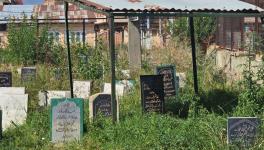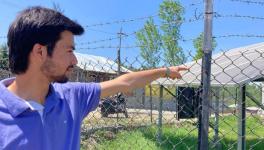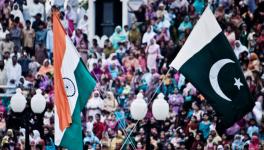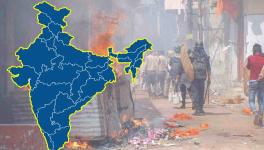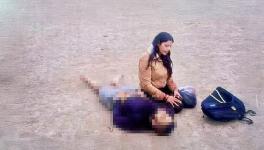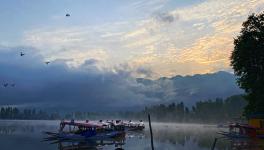Inside Zadibal: The Siege, Clashes and Reverence
Srinagar: In Kashmir, restrictions and clashes marked the tenth day of Muharram called the Ashura, a holy day observed by Shia Muslims across the world. Scores were injured—many of them grievously in their eyes—after security personnel fired pellet guns at the mourners.
According to eye-witnesses, the police and paramilitary fired tear gas shells and pellet shotguns without any provocation at “peaceful mourners” in Zadibal locality, which is a Shia-dominated area in Srinagar, leading to clashes that went on for hours Sunday evening. Among those injured included women.
A person in his early twenties was among those hit by pellets. Both of his eyes were closed as he writhed in pain when two other youths picked him up to take him to the hospital. “The police did not allow us despite several pleas. Without losing much time, we evacuated him through Khushal Sar in a boat,” his attendant told NewsClick at Srinagar's Shri Maharaja Hari Singh Hospital.
Inside Zadibal, which is built around the shrine of Mir Shamsuddin Iraqi, a prominent medieval Shia scholar believed to have established the Shia sect in the valley, the locals were brimmed with anger and disbelief. A siege was laid around the area by the personnel of J&K police and paramilitary including the CRPF and SSB to thwart any attempts by the locals to take out processions. Khushal Sar is a small decaying lake behind the locality which many of these protesters used to reach the hospital or escape from the locality.
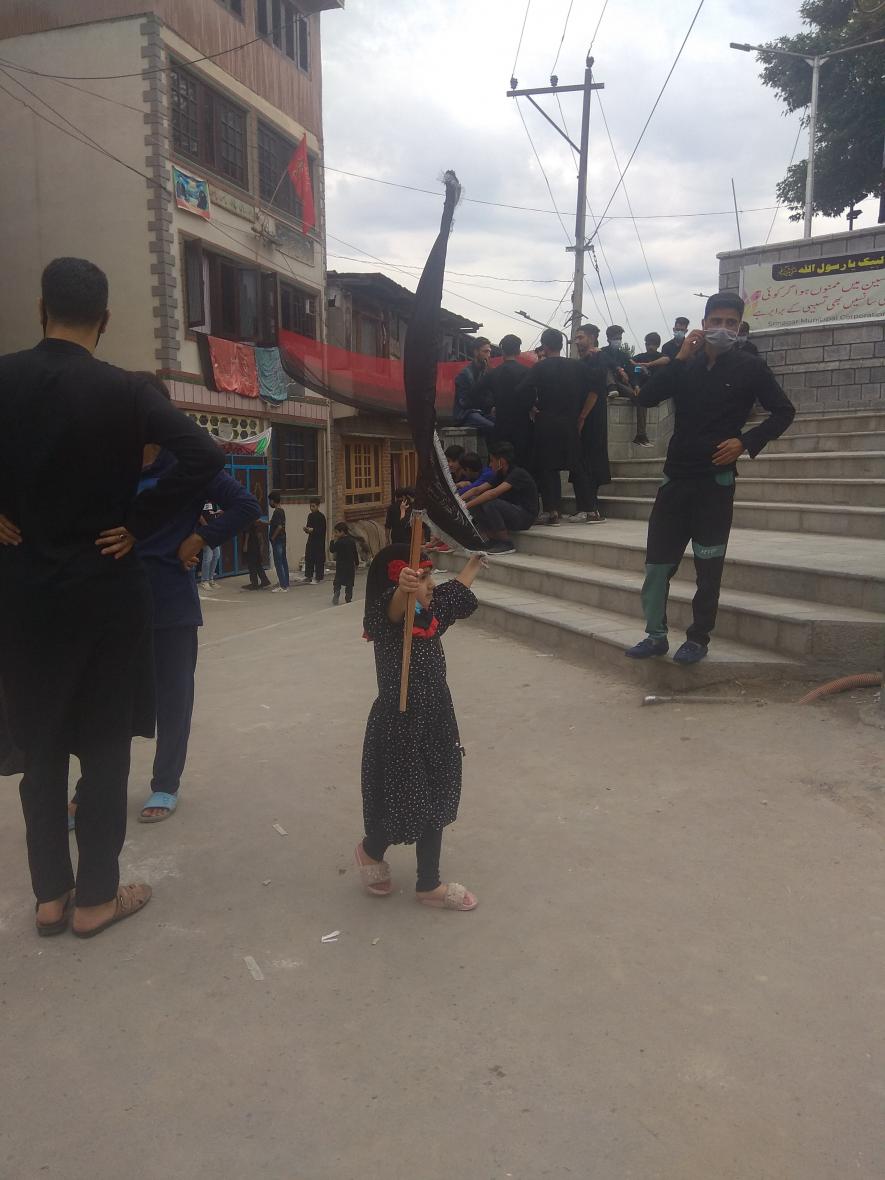
“They did not allow the ambulances to enter Zadibal even the one from the state health department. The ambulances inside belong to the NGOs or local social or religious groups who are part of the Muharram preparations,” a local municipal representative, Tanveer Pathan, said.
Pathan is “disappointed” with the way the administration, he says, neglected the locality in Muharram. “They have laid a siege in this area to prevent the processions. It seems there are more security personnel here than the locals and they have blocked all the roads even for an emergency,” he said.
Shia Muslims observe Ashura to mourn the killing of Prophet Muahmmad’s grandson Imam Husain during a siege by Yazid’s army of the Umayyad Caliphate in the battle of Karbala around 680 AD.
The Shia population in Jammu and Kashmir is reported to be around 14% of the total population and in the Valley, they live mostly in Srinagar and Budgam districts. The Shia Muslims traditionally take out processions through various internal routes to commemorate the holy days of the Muharram month with the processions on 8th and 10th day being two of the most significant.
The administration said it imposed curbs on all religious gatherings including on the Muharram processions this year in the wake of the global outbreak of COVID-19. The locals at Zadibal, however, believe that the ban on Muharram processions has reasons beyond the pandemic.
In 2011, the BJP carried out a survey in the Valley in an attempt to profile the Shia population believing that the Shia voters’ participation in the elections especially in Srinagar and Budgam can be utilised as a “sectarian faultline” against the majority Sunni population.
The authorities allowed the processions for years until 2010 when the entire Valley witnessed a summer-long protests and clashes in which nearly 120 civilians were killed. These major processions were barred since then as the government feared that they might turn political and subsequently, a law and order problem. The smaller intra-locality processions were, however, allowed.
In the year 2018, in the Muharram processions at Srinagar and Budgam, mourners commemorated slain Hizbul Mujahideen commander Burhan Wani while they raised pro-freedom slogans. The next year in 2019, the holy days of Muharram coincided with the restrictions imposed in the region in the wake of the abrogation of Article 370. All the processions were banned resulting in the clashes between the locals and government forces which continued this year as well.
Many locals raise black flags during the Muharram on their balconies, windows and porches. The Shia localities including Zadibal are marked with the portraits of prominent Shia leaders including the architect of Iranian revolution Ayatollah Khomeini, present Ayatollah Khamenei and Hezbollah’s top leader Hassan Nasrallah. Most of these portraits remain there throughout and in a way demarcate the Shia-dominated areas of the Valley. There are also two recent but prominent additions – Qassem Soleimani, the high-profile Iranian Islamic Revolutionary Guard commander who was assassinated earlier this year in Iraq and Mohsin Hojaji, a young Iranian military officer killed by Daesh forces three years ago in Syria.
In the early 1990s, a Shia militant group was active in the Valley called the Hizbul Momineen dominated by Shia recruits. The group, not as significant as the other outfits like Hizbul Mujahideen and LeT, was believed to have carried out attacks even in the early 2000s, but soon waned into obscurity.
The locals waive the flags of Iran as well as Hezbollah due to the unmatched reverence Iran and its allies enjoy amongst the Kashmiri Shias.
“The police warned us not to waive the flag of Hezbollah,” a local from Zadibal said. In his early 20s, the youth who wished anonymity said that this amounts to their “tacit support” to the Israeli state.
Earlier this month, Iran-backed Hezbollah’s deputy leader Sheikh Naim Qassem also extended his support to Kashmir’s “self-determination” at a time when the relationship between India and Iran—formerly strong allies—is shifting under geo-political stress.
“Even if they removed all the flags, the flag of Hezbollah is in our hearts and so is our solidarity with the Palestinians against Israel,” the youth said outside Iraqi’s shrine.
He was waiting with many others, mostly young, to join the Ashura procession since morning but the elders of the locality had already decided against it. There were others, mostly elders, who wanted to avoid it as the procession route was manned by the forces. Most of them were angry over what had happened a day ago and two days back during the night.
On 9th Muharram, the police had shot at dozens of mourners in Bemina locality injuring many with at least two of them grievously in the eyes. “It was a peaceful protest and we were following all the SOPs and wearing masks, but the police still fired at us,” 19-year-old Suhail Abbas said.
Suhail’s body is perforated with pellets on the right side from his eyes to his elbow and upper back. He is unable to open his left eye which has swollen due to the hit and the wound. The doctors have already performed a surgery on his eye and he is waiting for the next at the SMHS hospital. “The doctors are saying they can save my eye,” the class 12 student told NewsClick.
Right next to him is another boy from Budgam, who was also injured during the same incident. But, 15-year-old Tanveer is still, his face covered with a sunshade cloth. Both of his eyes are damaged and are ridden with pellets. “I don’t know how many are there and I am not sure about his eye-sight,” his father Nazir Ahmad said in a broken voice.
The force used on protesters in Bemina enraged many in Zadibal too with many of them, mostly youths, condemning the act as a “conspiracy against Muslims”. As they waited to carry out a procession, they spoke against the Anjuman e Sharie, a local Shia body’s move to avoid any participation in the local congregations except a Majlis inside Iraqi’s shrine.
Some posters had already emerged in the locality calling for the boycott of Anjuman. “This is the work of a miscreant to create divisions,” Pathan said.
But, many among the youths and the elders were clearly divided. The police’s midnight lathicharge on women mourners on 3rd Muharram outside the shrine had also fuelled the tensions, which culminated in clashes later on Sunday injuring many including the policemen.
Get the latest reports & analysis with people's perspective on Protests, movements & deep analytical videos, discussions of the current affairs in your Telegram app. Subscribe to NewsClick's Telegram channel & get Real-Time updates on stories, as they get published on our website.









